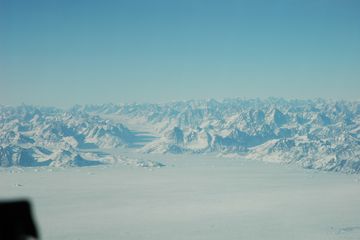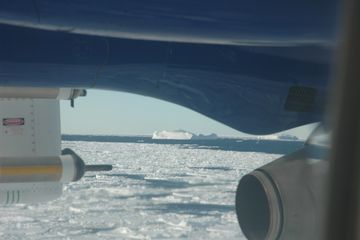

|
|
|||
|
|
|||
|
|
|||
|
|
|||
|
|
|||
|
|
|||
|
|
|||
|
|
|||
 |
|||
Monday 5th - Heat fluxes and Icebergs |
Todays flight plan involved heading pretty much due west out of Keflavik, before undertaking a series of low level legs across and along the Greenland barrier jet, to measure the amount of heat being transferred from the ocean to the atmosphere. The amount of time being spent around the turbulent 100 ft zone is unprecidented for FAAM, and the morning briefing repeatedly passed mention of methods of avoiding (or at least containing!) the effects of air-sickness. The morning got off to a less than ideal start when the ground handling agents failed to send anyone to open the hanger doors or tow the plane out into position. Eventually this was done and we should have been ready to go, however, the rather temperamental Horace - the plane's data handling computer - then decided to have a bit of a sulk, giving flight manager Alan a rather stressful few minutes trying to get everything back up and running before the flight had to be scratched. |
||||
This done, we finally took off at around 1120 and headed, at low level to avoid icing the all important turbulence probe, to the first waypoint (with only a minor detour to avoid some unfriendly looking weather). Here we started our true low level runs through the barrier jet, and though the turbulence was not as bad as expected it was enough to keep the majority of people awake. Most on board, however, were highly impressed with dropmaster Stu's ability to sleep like a baby through most of the low level work, perhaps in preparation for his upcoming dropsonde epic. Newcomer Tom Haine provided an interesting commentary of the local oceanography, an welcome contrast to the usual atmospheric focus of the campaign. As the plane neared the edge of the sea-ice, the cloud miraculously lifted before disappearing completely, leaving all on board with stunning views of the ice, Greenland, and a deep blue sky. The polar bear sitting atop an iceberg with cocktail in paw remains elusive. Further views of Greenland were enjoyed by most during the ascent to the start of the dropsonde leg, though many of the crew had to take this opportunity to rush to use the toilet after the record breaking 3.5 hour low level stint. The second record of the day was then broken by Stu successfully launching eight dropsondes in under half an hour to allow us to get high resolution measurements of the vertical structure of the barrier jet. The evening was spent in one of our regular eating haunts, before everyone retired for an early night, tired but satisfied with another successful GFDex flight. |
||||

